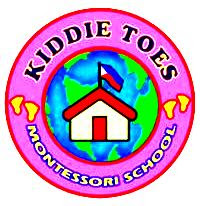GIVE YOUR CHILD THE WORLD!
Be part of the Kiddie Toes Montessori School Family!
Our elementary level follows the Progressive Education Method. We also use the Singapore Math Curriculum.
The Progressive Education’s main objective is to educate the "whole child" (physical, emotional and intellectual)
Qualities:
• Emphasis on learning by doing (experiential learning)
• Integrated curriculum focused on thematic units
• Strong emphasis on problem solving and critical thinking
• Group work and development of social skills
• Collaborative and cooperative learning projects
• Education for social responsibility and democracy
• Integration of community service and service learning projects into the daily curriculum
• Selection of subject content by looking forward to ask what skills will be needed in future society
• De-emphasis on textbooks in favor of varied learning resources
• Emphasis on life-long learning and social skills
Our elementary level follows the Progressive Education Method. We also use the Singapore Math Curriculum.
The Progressive Education’s main objective is to educate the "whole child" (physical, emotional and intellectual)
Qualities:
• Emphasis on learning by doing (experiential learning)
• Integrated curriculum focused on thematic units
• Strong emphasis on problem solving and critical thinking
• Group work and development of social skills
• Collaborative and cooperative learning projects
• Education for social responsibility and democracy
• Integration of community service and service learning projects into the daily curriculum
• Selection of subject content by looking forward to ask what skills will be needed in future society
• De-emphasis on textbooks in favor of varied learning resources
• Emphasis on life-long learning and social skills
School facilities
- Airconditioned classrooms
- Highly qualified Teachers
- Imported learning materials
- English as the medium of instruction
- Spacious play area
- Ideally located in the center of the city
- Comfortable waiting area
- Highly qualified Teachers
- Imported learning materials
- English as the medium of instruction
- Spacious play area
- Ideally located in the center of the city
- Comfortable waiting area
Thursday, June 7, 2012
Another Trick for Getting Kids to Eat Their Veggies: Serve Them Less
Another Trick for Getting Kids to Eat Their Veggies: Serve Them Less
By Beth Fontenot
Kids are not likely to make balanced choices on their own, so giving them too much of a favorite entree will keep them from trying other things.
If you want your preschooler to eat more fruits and vegetables, give them smaller portions -- of the main dish, that is.
Researchers at The Pennsylvania State University in University Park found that giving preschool children smaller portions of the entrée at the lunch meal resulted in greater consumption of fruit and vegetables and a smaller intake of calories.
Seventeen kids in a Pennsylvania preschool were served six different variations of the same meal one day a week for lunch. The main dish was macaroni and cheese, and the amount served varied from less than half a cup to more than a cup and a half. The lunch menu also included green beans, unsweetened applesauce, a whole grain roll, and milk.
When the children ate all of the smallest portion of macaroni and cheese, they ate nearly half of the other foods served, including fruits and vegetables. However, when the kids were served the largest portion of mac and cheese, they only ate about a fourth of the side dishes.
The number of calories the kids consumed for lunch varied with the size of the main dish as well. When served the largest portion of the entrée, they ate an average of 506 calories. With the smallest portion, they consumed 315 calories.
As with adults, children fall short in the consumption of fruits and vegetables, and these findings may provide parents with another tool to encourage their kids to eat more produce. When children fill up on mac and cheese or chicken strips or spaghetti, their intake of fruits and vegetables will surely suffer.
Parents need to be certain they are serving their children age-appropriate portions of food. Appropriate servings of food per day for young children by food group are: Grains, 3-4 ounces; vegetables, 1 1/2 cups; fruit, 1 1/2 cups; milk, two cups; meats, 2-3 ounces.
In general, the range of calories recommended for children two to five years old is 1,000 to 1,600, and servings sizes are about half of the suggested portion sizes for adults. One way a parent can decide if they are serving appropriate amounts of food is to check their child's lunch box, see what wasn't eaten, and talk to their child about it. Observing what they leave on their plates at home will accomplish the same thing.
Young children are not likely to make balanced food choices on their own when presented with large portions of a main dish that they like, so parents need to guide them by presenting with them age-appropriate servings. In addition, children tend to follow the example of parents and older siblings so when they see those they look up to eating fruits and vegetables as snacks and filling up on those side dishes at meals, they are likely to follow suit.
The study was published online in the American Journal of Clinical Nutrition.
Image: Gyorgy Barna/Shutterstock.
This article originally appeared on TheDoctorWillSeeYouNow.com, an Atlantic partner site.
This article available online at:
http://www.theatlantic.com/health/archive/2012/02/another-trick-for-getting-kids-to-eat-their-veggies-serve-them-less/252424/
Copyright © 2012 by The Atlantic Monthly Group. All Rights Reserved.
Subscribe to:
Posts (Atom)


